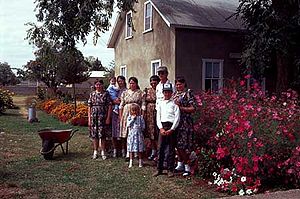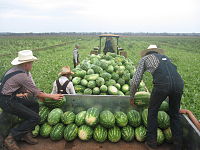- Mennonites in Mexico
-
Mennonites in Mexico 
Mennonite family in Cuauhtémoc.Total population 80,000[1] Regions with significant populations Campeche, Chihuahua, Durango, Zacatecas, Quintana Roo, San Luis Potosí, Jalisco, Aguascalientes, Sonora, Baja California Religions Anabaptist Scriptures The Bible Languages Plautdietsch, English, Spanish There are 80,000 to 90,000 Mennonites living in Mexico.[2] They live in several areas, particularly in the states of Campeche, Sonora, Chihuahua, Zacatecas and Durango and their settlements were first established in the 1920s.[3]
Contents
History
In the period leading up to and during World War I, provincial governments in Manitoba and Saskatchewan passed laws requiring public schools to fly the Union Jack, required compulsory attendance, and forcibly created public schools in areas of Mennonite settlement. In response the more conservative Mennonites sent out delegates to a number of countries to seek out a new land for settlement. They finally settled in a tract of land in Northern Mexico after negotiating certain privileges with then Mexican President Álvaro Obregón. Approximately 6,000 of the most conservative Mennonites eventually left Manitoba and Saskatchewan for Mexico. The first train left Plum Coulee, Manitoba on March 1, 1922. Many Mennonites immigrants settled in Northern Mexico from Pennsylvania, Ohio, Indiana, Illinois, Missouri and Canada.
Between 1922 and 1925 some 3,200 members of the Reinlaender Gemeinde in Manitoba and 1,200 from the Swift Current area left Canada to settle in Northern Mexico on approximately 230,000 acres of land in the Bustillos Valley near present day Cuauhtémoc in Northern Mexico. The Manitoba and Swift Current area groups settled the Manitoba and Swift Colonies in Chihuahua State, while about 950 Mennonites from the Hague-Osler settlement in Saskatchewan settled on 35,000 acres in Durango State.[4]
Settlements
Using modern methods by Mexican standards, the Mennonites established farms, machine shops and motorized vehicles for transporting produce (although automobiles were forbidden for common use). Canadian oats, beans and corn were the main produce. Forty settlements were established. The villages followed Mennonite architectural styles existent in Russia and Canada and the names were based on former names in Canada such as Rosenort, Steinbach and Schönwiese. Four Colonies were initially established:the Swift Current Colony, the larger Manitoba Colony and a smaller Santa Clara settlement in the Cuauhtemoc area. The fourth was the Durango Colony near Nuevo Ideal. The Colonies were based on former Mennonite social structures in terms of education and similar prayer houses and unsalaried ministers. Conservative dress and traditional roles for women were the norm.
Present
In Chihuahua, Mennonites continue their lifestyle with several reforms, such as the use of automobiles, although most use horse and buggy. They coexist, learning Spanish and English and living side by side with Tarahumara Indians in the hill country of the state. About 50,000 Mennonites reside near the city of Cuauhtémoc in Chihuahua. In Durango, there are 32 Mennonite communities (30 in the Municipality of Nuevo Ideal and 2 and the Municipality of Santiago Papasquiaro). Mennonites in Durango number more than 7,000 most of them living in Nuevo Ideal. Nuevo Ideal's lies around 124 kilometers, north of Durango City. Once in Nuevo Ideal, it becomes central transit point where the main roads that communicate Northwest and Northeast Durango separate (the road going northwest to Tepehuanes is paved while the one going to Escobedo, Durango towards the northeast, is a dirt road). Mennonites benefit from this transit point since many travelers and truck drivers stop in Nuevo Ideal in search of Menonita Cheese.
The largest denomination as of 2006 is Altkolonier Mennonitengemeinde with 17,200 members. Evangelical Mennonite Mission Conference has 97 members, Kleingemeinde in Mexiko has 2,150 members, Reinländer-Gemeinde has 1,350 members & Sommerfelder Mennonitengemeinde has 2,043 members.[5]
Since the start of the Mexican Drug War, many Mennonite colonies in Chihuahua have suffered the impact of the drug-related violence. The location of the colonies and the economic success of the Mennonites are the reasons why the community has been affected. The economic achievements have attracted the attention of organized criminal gangs, putting Mennonites at risk of armed robbery, kidnap and extortion. A small number of Mennonites have left the settlements and immigrated to other Mennonite settlements in Belize and Paraguay to escape the violence. Thousands have moved and settled in more secure Mexican states like Campeche, or moved to South America, in countries like Argentina and Bolivia[6]
There are accusations within the Mennonites that there are some Mennonites involved in the drug trade.,[7][8] the accusations were never proved.
During 2007, the colony of Salamanca (a Mennonite settlement with a population of 800 spread over 2,000 hectares in the state of Quintana Roo) was completely destroyed due to the landfall of Hurricane Dean.[9] As of 2008, Salamanca had a population of 862.[10]
Film
The Mexican Mennonite community was the setting for the 2007 film Stellet Licht by acclaimed Mexican director Carlos Reygadas.
See also
- Mennonites in Netherlands
- Mennonites in Paraguay
- Mennonites in France
- Mennonites in Belize
- Mennonites in Bolivia
References
- ^ "Mennonite & Brethren in Christ World Membership". Mennonite World Conference. 2006. http://www.mwc-cmm.org/Directory/2006mbictotal.pdf. Retrieved 2008-06-28.
- ^ Of these, 25,958 are adult church members.
- ^ "The Mennonite Old Colony Vision: Under siege in Mexico and the Canadian Connection" (PDF). http://www.hshs.mb.ca/mennonite_old_colony_vision.pdf. Retrieved 2007-05-30.
- ^ Ens, Adolf (1994). Subjects or Citizens?: The Mennonite Experience in Canada, 1870-1925. University of Ottawa Press. pp. 208. ISBN 0-7766-0390-6.
- ^ http://www.mwc-cmm.org/en15/PDF-PPT/2006carcsam.pdf
- ^ http://www.nuevoidealdurango.com/?p=689
- ^ "Drug war hits Mexico's Mennonites". BBC News. 2009-11-23. http://news.bbc.co.uk/2/hi/8369200.stm. Retrieved 2010-05-12.
- ^ http://www.theworld.org/2009/12/23/mexican-mennonites/
- ^ Ovalle, David; Merzer, Martin (2007-08-23). "Dean makes for misery among Mennonites". The Seattle Times. http://seattletimes.nwsource.com/html/nationworld/2003849153_hurricane23.html.
- ^ http://www.elsiglodetorreon.com.mx/noticia/328090.html
External links
- Mexico at Global Anabaptist Mennonite Encyclopedia Online
- Protective Retreat: Mexico's Mennonites Consider a New Migration - The World and I
Mennonites in the Americas North America · South America Sovereign states - Antigua and Barbuda
- Argentina
- Bahamas
- Barbados
- Belize
- Bolivia
- Brazil
- Canada
- Chile
- Colombia
- Costa Rica
- Cuba
- Dominica
- Dominican Republic
- Ecuador
- El Salvador
- Grenada
- Guatemala
- Guyana
- Haiti
- Honduras
- Jamaica
- Mexico
- Nicaragua
- Panama
- Paraguay
- Peru
- Saint Kitts and Nevis
- Saint Lucia
- Saint Vincent and the Grenadines
- Suriname
- Trinidad and Tobago
- United States
- Uruguay
- Venezuela

Dependencies and
other territories- Anguilla
- Aruba
- Bermuda
- Bonaire
- British Virgin Islands
- Cayman Islands
- Curaçao
- Falkland Islands
- French Guiana
- Greenland
- Guadeloupe
- Martinique
- Montserrat
- Navassa Island
- Puerto Rico
- Saint Barthélemy
- Saint Martin
- Saint Pierre and Miquelon
- Saba
- Sint Eustatius
- Sint Maarten
- South Georgia and the South Sandwich Islands
- Turks and Caicos Islands
- US Virgin Islands
Categories:- Mennonitism in Mexico
Wikimedia Foundation. 2010.


